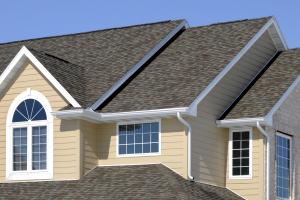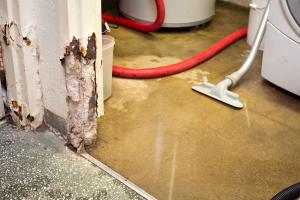Prevent roof damage to your home

Your roof may be the most important layer of protection against the impact of hail, heavy rain and damaging wind on your home. According to the Insurance Institute for Business & Home Safety, roof-related damage is responsible for 70-90% of total insured residential catastrophic losses.
Avoiding storms altogether may be impossible, but taking these steps can help ensure your home’s roof is in the best condition possible to withstand the weather.
Keep your roof clear
Remove debris that can accumulate on your roof, such as tree limbs, extra dirt, loose objects, moss, algae and anything else that shouldn’t be up there. Be sure to clean out any adjacent gutters and downspouts to keep water off the roof and flowing away from the house.
In addition, safely trim any tree branches hanging over your roof to prevent damage that could be caused by:
- Limbs rubbing or hitting your roof during a windy storm
- Broken limbs
- Debris such as pine needles and leaves
Inspect your roof regularly
Look for any signs of minor roof damage that could turn into major concerns during a sudden weather event, such as:
- Missing/curled shingles
- Sagging areas
- Cracks
- Damage to the flashing
- Rotting wood/insect infestation
If any wear and tear is apparent, make repairs as soon as possible.
Remove winter precipitation
Use long-handled tools, such as a roof rake, to safely remove snow and ice from your roof after every winter weather event. This will take the stress of accumulating snow weight off your roof and prevent additional moisture from getting into roof shingles and small cracks that can cause further problems down the road.
Use calcium chloride ice melt and a roof rake to help avoid ice dams, but if they form, take steps right away to remove them.
Check for interior signs of roof trouble
Look for signs of water damage in both your attic and ceiling, which can indicate an unhealthy roof. Check to ensure your attic is well insulated and has air vents that provide necessary ventilation to discourage ice dams.
Check your ceiling on the top floor for signs of moisture issues, such as water marks. Make any repairs right away to ensure the roof is not sitting on a soggy foundation.
Sources
Related resources
Prevent roof damage to your home
Your roof may be the most important layer of protection against the impact of hail, heavy rain and damaging wind on your home. According to the Insurance Institute for Business & Home Safety, roof-related damage is responsible for 70-90% of total insured residential catastrophic losses.
Avoiding storms altogether may be impossible, but taking these steps can help ensure your home’s roof is in the best condition possible to withstand the weather.
Keep your roof clear
Remove debris that can accumulate on your roof, such as tree limbs, extra dirt, loose objects, moss, algae and anything else that shouldn’t be up there. Be sure to clean out any adjacent gutters and downspouts to keep water off the roof and flowing away from the house.
In addition, safely trim any tree branches hanging over your roof to prevent damage that could be caused by:
- Limbs rubbing or hitting your roof during a windy storm
- Broken limbs
- Debris such as pine needles and leaves
Inspect your roof regularly
Look for any signs of minor roof damage that could turn into major concerns during a sudden weather event, such as:
- Missing/curled shingles
- Sagging areas
- Cracks
- Damage to the flashing
- Rotting wood/insect infestation
If any wear and tear is apparent, make repairs as soon as possible.
Remove winter precipitation
Use long-handled tools, such as a roof rake, to safely remove snow and ice from your roof after every winter weather event. This will take the stress of accumulating snow weight off your roof and prevent additional moisture from getting into roof shingles and small cracks that can cause further problems down the road.
Use calcium chloride ice melt and a roof rake to help avoid ice dams, but if they form, take steps right away to remove them.
Check for interior signs of roof trouble
Look for signs of water damage in both your attic and ceiling, which can indicate an unhealthy roof. Check to ensure your attic is well insulated and has air vents that provide necessary ventilation to discourage ice dams.
Check your ceiling on the top floor for signs of moisture issues, such as water marks. Make any repairs right away to ensure the roof is not sitting on a soggy foundation.
Sources
Related resources
Prevent roof damage to your home
Your roof may be the most important layer of protection against the impact of hail, heavy rain and damaging wind on your home. According to the Insurance Institute for Business & Home Safety, roof-related damage is responsible for 70-90% of total insured residential catastrophic losses.
Avoiding storms altogether may be impossible, but taking these steps can help ensure your home’s roof is in the best condition possible to withstand the weather.
Keep your roof clear
Remove debris that can accumulate on your roof, such as tree limbs, extra dirt, loose objects, moss, algae and anything else that shouldn’t be up there. Be sure to clean out any adjacent gutters and downspouts to keep water off the roof and flowing away from the house.
In addition, safely trim any tree branches hanging over your roof to prevent damage that could be caused by:
- Limbs rubbing or hitting your roof during a windy storm
- Broken limbs
- Debris such as pine needles and leaves
Inspect your roof regularly
Look for any signs of minor roof damage that could turn into major concerns during a sudden weather event, such as:
- Missing/curled shingles
- Sagging areas
- Cracks
- Damage to the flashing
- Rotting wood/insect infestation
If any wear and tear is apparent, make repairs as soon as possible.
Remove winter precipitation
Use long-handled tools, such as a roof rake, to safely remove snow and ice from your roof after every winter weather event. This will take the stress of accumulating snow weight off your roof and prevent additional moisture from getting into roof shingles and small cracks that can cause further problems down the road.
Use calcium chloride ice melt and a roof rake to help avoid ice dams, but if they form, take steps right away to remove them.
Check for interior signs of roof trouble
Look for signs of water damage in both your attic and ceiling, which can indicate an unhealthy roof. Check to ensure your attic is well insulated and has air vents that provide necessary ventilation to discourage ice dams.
Check your ceiling on the top floor for signs of moisture issues, such as water marks. Make any repairs right away to ensure the roof is not sitting on a soggy foundation.
Sources
Related resources
Prevent roof damage to your home
Your roof may be the most important layer of protection against the impact of hail, heavy rain and damaging wind on your home. According to the Insurance Institute for Business & Home Safety, roof-related damage is responsible for 70-90% of total insured residential catastrophic losses.
Avoiding storms altogether may be impossible, but taking these steps can help ensure your home’s roof is in the best condition possible to withstand the weather.
Keep your roof clear
Remove debris that can accumulate on your roof, such as tree limbs, extra dirt, loose objects, moss, algae and anything else that shouldn’t be up there. Be sure to clean out any adjacent gutters and downspouts to keep water off the roof and flowing away from the house.
In addition, safely trim any tree branches hanging over your roof to prevent damage that could be caused by:
- Limbs rubbing or hitting your roof during a windy storm
- Broken limbs
- Debris such as pine needles and leaves
Inspect your roof regularly
Look for any signs of minor roof damage that could turn into major concerns during a sudden weather event, such as:
- Missing/curled shingles
- Sagging areas
- Cracks
- Damage to the flashing
- Rotting wood/insect infestation
If any wear and tear is apparent, make repairs as soon as possible.
Remove winter precipitation
Use long-handled tools, such as a roof rake, to safely remove snow and ice from your roof after every winter weather event. This will take the stress of accumulating snow weight off your roof and prevent additional moisture from getting into roof shingles and small cracks that can cause further problems down the road.
Use calcium chloride ice melt and a roof rake to help avoid ice dams, but if they form, take steps right away to remove them.
Check for interior signs of roof trouble
Look for signs of water damage in both your attic and ceiling, which can indicate an unhealthy roof. Check to ensure your attic is well insulated and has air vents that provide necessary ventilation to discourage ice dams.
Check your ceiling on the top floor for signs of moisture issues, such as water marks. Make any repairs right away to ensure the roof is not sitting on a soggy foundation.





